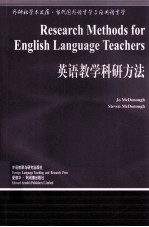图书介绍
英语教学科研方法pdf电子书版本下载

- (英)麦克多诺(McDonoughJ.)等著;刘润清导读 著
- 出版社: 北京:外语教学与研究出版社;爱德华·阿诺德出版社
- ISBN:7560085296
- 出版时间:2012
- 标注页数:267页
- 文件大小:11MB
- 文件页数:304页
- 主题词:
PDF下载
下载说明
英语教学科研方法PDF格式电子书版下载
下载的文件为RAR压缩包。需要使用解压软件进行解压得到PDF格式图书。建议使用BT下载工具Free Download Manager进行下载,简称FDM(免费,没有广告,支持多平台)。本站资源全部打包为BT种子。所以需要使用专业的BT下载软件进行下载。如 BitComet qBittorrent uTorrent等BT下载工具。迅雷目前由于本站不是热门资源。不推荐使用!后期资源热门了。安装了迅雷也可以迅雷进行下载!
(文件页数 要大于 标注页数,上中下等多册电子书除外)
注意:本站所有压缩包均有解压码: 点击下载压缩包解压工具
图书目录
Introduction:setting the scene 1
Part 1:principles and perspectives 5
1.Teachers in action 7
Introduction 7
Context and roles 8
Instances 10
Patterns of research:implications 14
Conclusion 17
Discussion notes 19
2.The teacher researcher in focus 21
Introduction 21
Action and reflection 22
A short educational excursion 25
Teacher research and English language teaching 28
Conclusion 34
Discussion notes 35
3.What is research? 37
Introduction 37
General views 37
Common views of what research in language teaching does 41
Basic and applied research 42
Description and intervention 44
Normative and interpretive research 47
Conclusion 54
Discussion notes 55
4.Principles and problems:what makes good research? 57
Introduction 57
Features of good research 57
Comparison of research traditions on these features 69
Aspects of design of research 70
Conclusion 72
Discussion notes 73
5.Generating research 75
Introduction 75
Beginnings 75
Approaches 78
Content:teachers'choices 81
Research and research:existing work 84
Conclusion 88
Discussion notes 89
Part 2:topics and methods 91
6.Definitions and overview 93
Principles,methods,techniques 93
Introduction to methods and techniques 95
Out there:discovering other people's work and telling them about one's own 96
7.Observing language classrooms 101
Introduction 101
Observation:uses and perspectives 101
Systematizing observation 105
Alternatives to coding schemes 111
Naturalistic observation 114
Conclusion 118
Discussion notes 119
8.Diaries and diary studies 121
Introduction 121
Some definitions 121
Diary data 122
Diaries in language learning and language teaching 127
Keeping a diary 134
Conclusion 136
Discussion notes 136
9.Using numbers 137
Introduction 137
Why count,and what to count 138
Describing the numbers with other numbers 139
Inference from chance-'significance' 150
Computational aids 152
Conclusion 153
Discussion notes 153
10.Doing experiments 155
Introduction 155
Why experiments? 155
Causality and the method of detail 157
Experiments and quasi-experiments 158
Some examples 161
Reflections on the experimental approach 165
Conclusion 168
Discussion notes 169
11.Asking questions 171
Introduction 171
Questionnaires 172
Interviews 181
Issues in interviewing 185
Conclusion 187
Discussion notes 188
12.Looking inside:methods for introspection 189
Introduction 189
Introspection 190
Verbal report and think-aloud 191
Research on oneself 194
Research on learners 196
Some examples 200
Conclusion 201
Discussion notes 202
13.Studying cases 203
Introduction 203
What is a case? 203
Methods in case study research 207
Case studies in language learning and teaching 209
The controversy of case study 216
Conclusion 218
Discussion notes 218
14.Mixing research methods 219
Introduction 219
Principles in mixing methods 219
Teachers'research:some continuing case studies 225
Conclusion 231
Discussion notes 232
Conclusion 233
The role of research by teachers 233
Appropriate methodologies 234
Development of criteria 235
'Popularity'of various techniques 236
Teacher research and higher-degree research 236
Evaluations of teacher research 237
And finally 239
Appendix 241
References 247
Index 257
文库索引 263